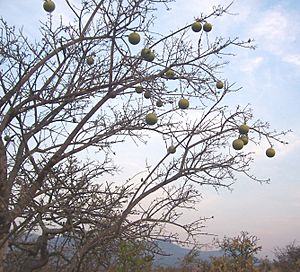Natal orange facts for kids
Quick facts for kids Natal orange |
|
|---|---|
 |
|
| Scientific classification | |
| Genus: |
Strychnos
|
| Species: |
spinosa
|
The Natal orange (scientific name: Strychnos spinosa) is a fascinating tree that grows naturally in warm parts of Africa. It's known for its tasty, sweet-sour yellow fruits. These fruits have many hard, brown seeds inside. The tree also produces greenish-white flowers that grow in bunches at the end of branches, usually from September to February. The fruits often appear after good rain.
Even though it's related to a dangerous plant called Strychnos nux-vomica (which has a poison called strychnine), the Natal orange fruit is generally safe to eat. Its fruits are large, smooth, and hard. They start green and turn yellow when they are ripe. Inside, the seeds are packed tightly and are surrounded by a soft, brown, edible part.
Many animals love to eat the fruit of the Natal orange. These include baboons, monkeys, bushpigs, nyalas, and eland. The leaves are also a favorite food for animals that browse, like duikers, kudus, impalas, steenboks, nyalas, and elephants.
Where It Grows
This amazing tree can be found growing by itself in areas with well-drained soil. You can spot it in different places like bushveld (open grasslands with scattered trees), along riverbanks, in sand forests, and in coastal bush.
Its natural home stretches from the Eastern Cape and Kwazulu-Natal in South Africa, all the way north to Mozambique. It also grows inland in countries like Eswatini, Zimbabwe, parts of Zambia, northern Botswana, northern Namibia, Angola, and Guinea Bissau. You can even find it in other tropical parts of Africa, including northwest Madagascar, southeast Madagascar at Sainte Luce Reserve, northwest Ethiopia, and western Tigray at Kafta Sheraro National Park. The Natal orange tree is tough and can even grow in dry and semi-dry lands.
Traditional Uses
People have used parts of the Natal orange plant in traditional ways for a long time. For example, the Tiv people in Nigeria use the plant, sometimes mixed with other plant extracts, for different purposes. They use it to help with snakebites and to boost physical strength.
Images for kids
See also
 In Spanish: Strychnos spinosa para niños
In Spanish: Strychnos spinosa para niños



